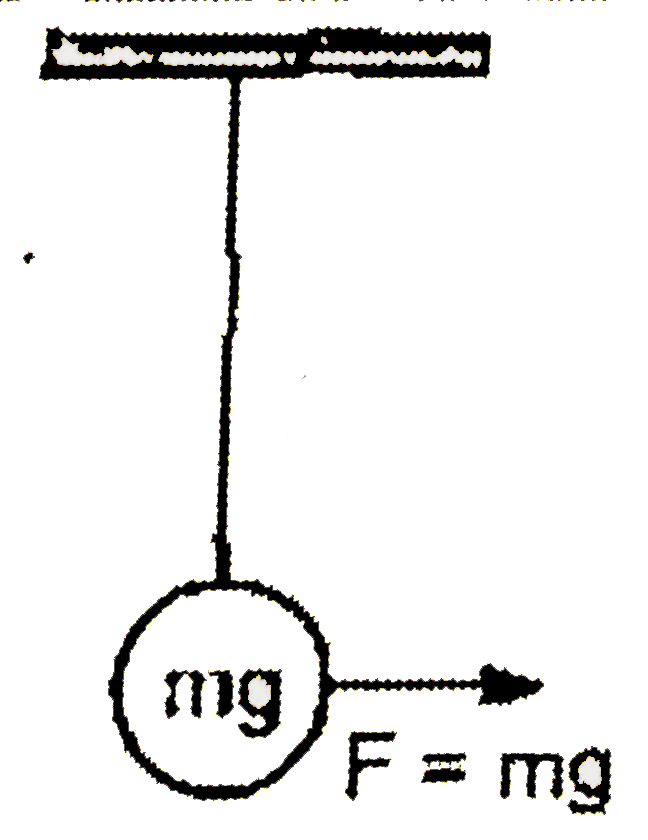A constant horizontal force F of magnitude equal to mg2 begins to act on the bob of pendulum shown when the bob was at rest. What maximum angle the string makes with the vertical ?

Let the string makes angle θ with the vertical when it comes to rest (momentarily) as shown
∴x=lsinθ
and h=l−lcosθ=l(1−cosθ)
Here work done by gravity
Wg=−mgh=−mgl(1−cosθ)
Work done by tension, WT=0[→T⊥→v]
Work done by force F,
WF=F× (displacement in the direction of F) = Fx
=mg2lsinθ
∴ Applying work-energy theorem

Wg+WF+WT=ΔK.E=0
∴12sinθ=1−cosθ
∴12sinθ=1−cosθ
∴tan(θ2)=12
∴θ=2tan−1(12)
Topper's Solved these Questions
- BOOK - MOTIONCHAPTER - WORK, POWER & ENERGY EXERCISE - QUESTIONS FOR PRACTICE25videos
WORK, POWER & ENERGY
- BOOK - MOTIONCHAPTER - WORK, POWER & ENERGY EXERCISE - Exercise - 142videos
WORK, POWER & ENERGY
- BOOK - MOTIONCHAPTER - WORK, POWER & ENERGY EXERCISE - EXAMPLES24videos
WORK, POWER & ENERGY
- BOOK - MOTIONCHAPTER - WAVESEXERCISE - EXERCISE -4 (Level -II) (previous year JEE Advanced)10videos
WAVES
Similar Questions
A small brass bob is revolving in a horizontal circle with a constant speed of 2ms−1 at the end of a string of length 1 m. Find the time required for one revolution of the body. What angle does the string make with the vertical ?
View SolutionA pendulum bob of mass m is suspended at rest. A constant horizontal force F=mg starts acting on it. Find
(a) the maximum angular defection of the string.
(b) the maximum possible tension in the string.
 View Solution
View Solution
Knowledge Check
- Question 1 - Select One
A car is moving with constant speed of 10m/s on a horizontal circular path of radius 10√3m . A bob of mass m suspended through a light string from the roof of the car. What is the angle made by the string with the vertical if the bob is stationary with respect to the car? (g = 10 m/s2)
Atan−1(√3)Btan−1(1√2)C30∘D45∘ - Question 2 - Select One
A small bob is suspended from the roof with a string and hangs vertically. The bob is given a charge +q and a uniform horizontal electric field is set up o the neighbourhood of the bob. Now the bob hangs intjhe field such that the string makes an angle of 30∘ with the vertical. If the charge on te bob is made +3q, and the bob once again comes to equilibrium, then the angle made by the string with the vertical will be
A30∘B45∘C60∘D90∘ - Question 3 - Select One
Two identical simple pendulums P and Q are susupended from a common point. The bobs of both the pendulums are positively charged but the magnitude of charge on the bob of P is double to that on Q, Both the bobs repel and reach equilibrium. If the thread of P makes an angle θ1 with the vertical and that of Q make an angle θ2 with the vertical, then
Aθ1>θ2Bθ1=θ2Cθ1<θ2DInformation insufficient
A simple pendulum of length 40 cm oscillates with an angular amplitude of 0.04 rad. Find a. the time period b. the linear amplitude of the bob, c. The speed of the bob when the strig makes 0.02 rad with the vertical and d. the angular acceleration when the bob is in moemntary rest. Take g=10ms−2.
View SolutionA simple pendulum is released from rest with the string in horizontal position. The vertical component of the velocity of the bob becomes maximum, when the string makes an angle θ with the vertical. The angle θ is equal to
View SolutionThe tension in the string of a simple pendulum is maximum, when the bob of the pendulum
View SolutionIn the previous question, when the string is horizontal, the net force on the bob is
View SolutionIn a conical pendulum , the centripetal force (mvr)2 acting on the bob is given by
View Solution
